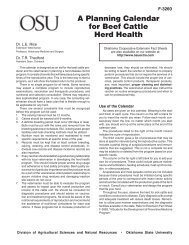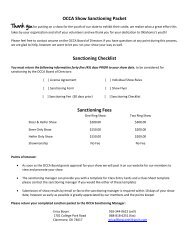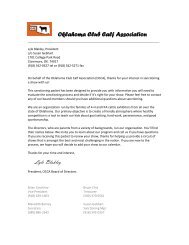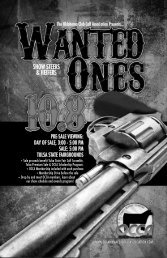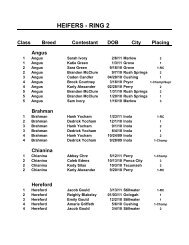Basics About Beef - the Oklahoma Club Calf Association
Basics About Beef - the Oklahoma Club Calf Association
Basics About Beef - the Oklahoma Club Calf Association
Create successful ePaper yourself
Turn your PDF publications into a flip-book with our unique Google optimized e-Paper software.
10<br />
COOKERY METHOD AND TIME<br />
The final factor in buying beef is preparation method. The cut<br />
you select depends largely on <strong>the</strong> method of meat cookery you<br />
plan to use. Moist heat methods, like braising and stewing, are<br />
best used with less expensive, less tender cuts, such as <strong>the</strong> chuck<br />
and <strong>the</strong> round. Dry heat methods, like broiling, are best with<br />
tender cuts from <strong>the</strong> loin and rib. For specific information on<br />
different cooking methods, see pages 15-19.<br />
You can make any beef cut tender and good-tasting if you use<br />
<strong>the</strong> right cooking method. Not all beef cuts should be cooked<br />
<strong>the</strong> same way. Many supermarkets are helping <strong>the</strong>ir customers<br />
by including cooking information right on <strong>the</strong> package. O<strong>the</strong>rs<br />
are even arranging meat cases according to cooking method.<br />
If your store doesn’t arrange its meat case with cooking<br />
information included, ask <strong>the</strong> meat manager how to cook<br />
<strong>the</strong> different cuts. You can also learn for yourself how to<br />
cook beef to get <strong>the</strong> most tender and best-tasting results.<br />
You just need to know a little about how muscles in <strong>the</strong> beef<br />
animal affect <strong>the</strong> tenderness of different beef cuts.<br />
The beef animal is made up of two types of muscles: suspension<br />
and locomotion. Suspension muscles are not used greatly in<br />
movement and have less connective tissue than locomotion<br />
muscles. (Connective tissue supports and reinforces <strong>the</strong> fibers in<br />
<strong>the</strong> muscles.) Locomotion muscles are used in movement and<br />
have more connective tissue.<br />
Generally, <strong>the</strong> most tender meat is from muscles which are not<br />
used greatly in movement and which have smaller amounts of<br />
connective tissue. Therefore, meat from suspension muscles is<br />
frequently more tender than meat from locomotion muscles.<br />
Early in <strong>the</strong> marketing chain, <strong>the</strong> beef carcass is divided into<br />
eight primals (wholesale cuts). The rib and loin primals are<br />
made up of suspension muscles (tender) and are found along<br />
<strong>the</strong> middle of <strong>the</strong> animal’s back. The locomotion muscles are<br />
found in <strong>the</strong> remaining primals which are usually less tender<br />
(e.g. chuck, flank, brisket). See illustration on page 12-13.<br />
There are recent trends in <strong>the</strong> beef industry which<br />
will result in new cuts, or muscles, from <strong>the</strong> chuck<br />
and <strong>the</strong> round offering <strong>the</strong> same tenderness as<br />
many of those from <strong>the</strong> rib and loin. These two<br />
primals, traditionally considered to be less tender,<br />
contain muscles which can provide lowfat, tender<br />
steaks and roasts. Consumers will soon see more<br />
variety and quality choices in supermarkets and restaurants.<br />
Until <strong>the</strong>se new cuts are available, look for <strong>the</strong> primal name,<br />
rib or loin, on <strong>the</strong> package label to ensure tenderness.<br />
1<br />
FILL IN THE<br />
SQUARES<br />
2<br />
Can you name an<br />
appropriate primal<br />
cut to fit each of <strong>the</strong><br />
four squares?<br />
3<br />
UNIFORM RETAIL MEAT LABELING<br />
Most retail stores across <strong>the</strong> U.S. have adopted a meat<br />
labeling program for all meats. The label used in <strong>the</strong><br />
program tells you:<br />
The kind of meat (<strong>Beef</strong>, Pork, Lamb or Veal).<br />
The primal (wholesale cut). Names such as<br />
Round, Chuck, Rib or Loin indicate where <strong>the</strong><br />
meat comes from on <strong>the</strong> carcass.<br />
The retail cut (names such as Top Round Steak,<br />
Blade Roast, or Short Ribs).<br />
See page 14 for information on <strong>the</strong> mandatory<br />
safe handling label.<br />
GROUND BEEF LABELING<br />
The current meat label (due for changes in 2006)<br />
indicates <strong>the</strong> leanness of ground beef. Ground beef<br />
can come from one of several muscles or primals.<br />
Its leanness depends upon where it comes from<br />
on <strong>the</strong> beef carcass. Leanness refers to <strong>the</strong> ratio or<br />
proportion of lean meat to fat.<br />
Less Lean Lean<br />
Tender<br />
Less Tender



